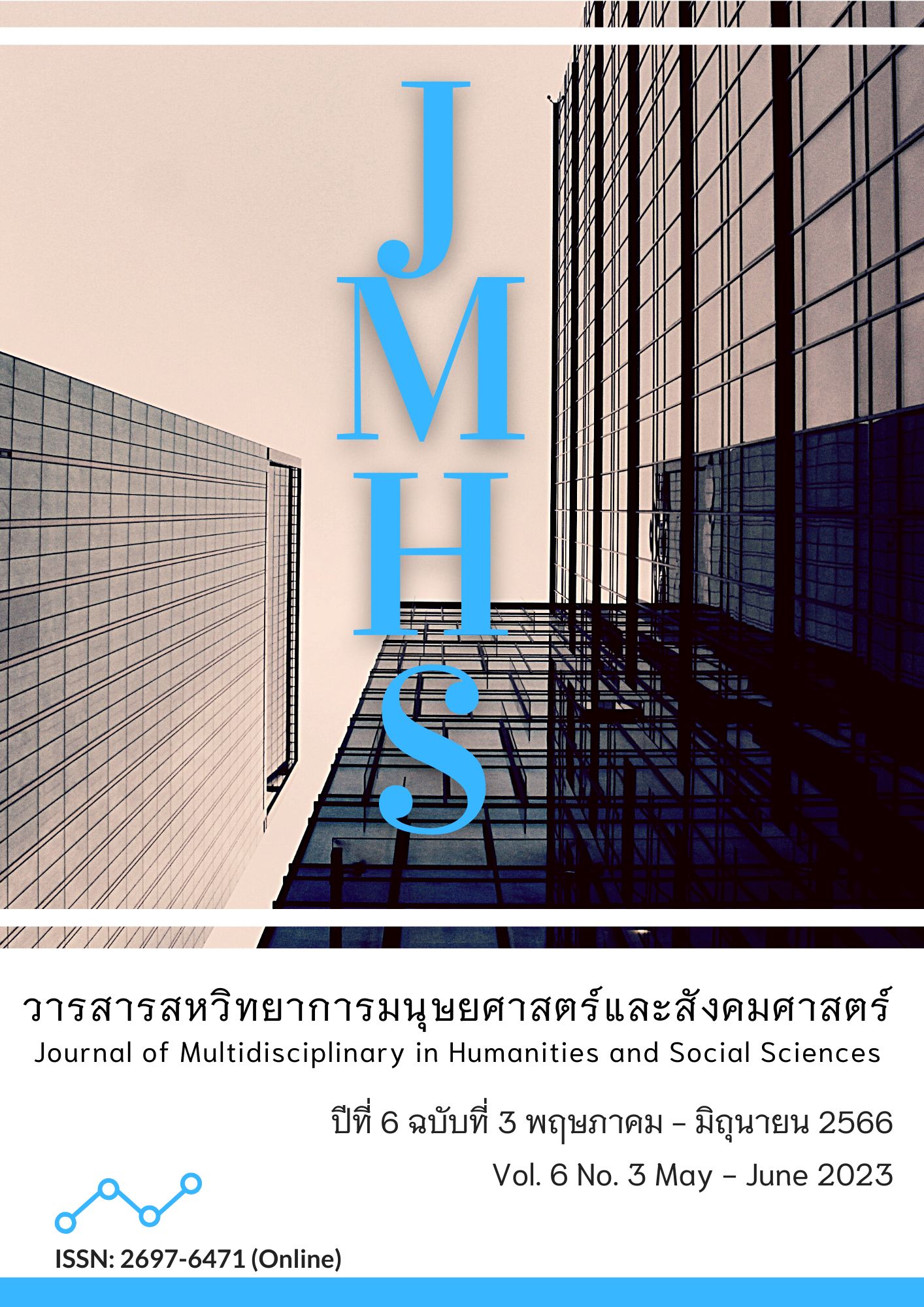The Smart School Development Model in the Digital Age Under the Office of the Basic Education Commission
Main Article Content
Abstract
The research objectives were to 1) study the composition and indicators of smart schools in the digital age under the Office of the Basic Education Commission; 2) study the current condition, the desirable conditions, and the need for assessment of smart school development in the digital age; and 3) propose a model. It’s divided into 3 steps: 1) studying the composition and indicators of being a smart school in the digital age as a conceptual framework for research; 2) surveying the current conditions, desirable conditions, and need assessment of smart school development in the digital age; and 3) proposing a model for developing smart schools in the digital age. Research tools include questionnaires and interview forms; the statistics used in the data analysis include the mean, percentage, and standard deviation. Pearson coefficient, Cronbach's alpha coefficient, and modified priority needs index (PNImodified) analysis.
The research results were as follows: 1. The composition of smart school development in the digital age consists of 3 elements (27 indicators), namely: 1) personnel (7 indicators), 2) management (12 indicators), and 3) media, innovation, and technology (8 indicators). The results of the assessment of suitability and feasibility are at the highest level. 2. On the current condition and desirable conditions of smart school development in the digital age, it was found that the overall current condition is moderate, with the most average issues being personnel, followed by management, and innovative media and technology. There were desirable conditions, as a whole, at the highest level. The issues with the highest average were personnel, followed by management, and innovative media and technology. The first need is personnel, followed by management, media, and technology, respectively, and 3. The smart school development model in the digital age consists of 7 steps according to the CARCARE Model.
Article Details

This work is licensed under a Creative Commons Attribution-NonCommercial-NoDerivatives 4.0 International License.
Views and opinions appearing in the Journal it is the responsibility of the author of the article, and does not constitute the view and responsibility of the editorial team.
References
กนกอร สมปราชญ์. (2560). ภาวะผู้นำและภาวะผู้นำการเรียนรู้สำหรับผู้บริหารสถานศึกษา. ขอนแก่น: มหาวิทยาลัยขอนแก่น.
กุลชลี จงเจริญ. (2557). ประมวลสาระวิชาการพัฒนาทักษะและประสบการณ์วิชาชีพสำหรับผู้นำทางการศึกษา หน่วยที่ 12 ภาวะผู้นำเชิงนวัตกรรม. นนทบุรี: มหาวิทยาลัยสุโขทัยธรรมาธิราช.
จิรพล สังข์โพธิ์, สุวรรณ จันทิวาสารกิจ และ เสาวณีย์ อยู่ดีรัมย์. (2560). ภาวะผู้นำในการบริหารยุคดิจิทัล: องค์การไอทีและองค์การที่เกี่ยวข้องกับไอทีในเขตกรุงเทพมหานครและปริมณฑล. กรุงเทพฯ: วิทยาลัยนวัตกรรม มหาวิทยาลัยธรรมศาสตร์.
ณัฐวุฒิ พงศ์สิริ. (2560). ผู้นำที่เรียกว่า Digital Leader ในยุคเศรษฐกิจดิจิทัล. HR Society Magazine, 15(172), 20-23.
ณิรดา เวชญาลักษณ์. (2560). ภาวะผู้นำทางการบริหาร. กรุงเทพฯ: สำนักพิมพ์แห่งจุฬาลงกรณ์มหาวิทยาลัย.
นวลจันทร์ จุฑาภักดีกุล. (2558). เด็กยุคดิจิทัล. ค้นเมื่อ 22 พฤษภาคม 2563, จาก http://ejournals.swu.ac.th/index.php/ENEDU/article/view/6704.
บุญชม ศรีสะอาด. (2553). หลักการวิจัยเบื้องต้น. กรุงเทพฯ: สุวีริยาสาส์น.
พชรวิทย์ จันทร์ศิริสิร. (2564). นโยบายและการวางแผนกลยุทธ์สำหรับสถาบันศึกษายุคใหม่. (พิมพ์ครั้งที่ 4). มหาสารคาม: อภิชาตการพิมพ์.
รุ่งชัชดาพร เวหะชาติ. (2550). การบริหารงานวิชาการสถานศึกษาขั้นพื้นฐาน. สงขลา: มหาวิทยาลัยทักษิณ.
วิรัช วิรัชนิภาวรรณ. (2561). การบริหารจัดการยุคดิจิทัล. กรุงเทพฯ: โฟร์เพซ.
สำนักงานคณะกรรมการการศึกษาขั้นพื้นฐาน. (2562). การพัฒนาผู้เรียนให้เป็นนักประดิษฐ์ จากบทเรียนการจัดการเรียนรู้ของครูผู้สร้างนักประดิษฐ์. กรุงเทพฯ: เอ็น 60 รัตนเทรดดิ้ง.
สำนักงานเลขาธิการสภาการศึกษา. (2560). แผนการศึกษาแห่งชาติ พ.ศ. 2560-2579. กรุงเทพฯ: กระทรวงศึกษาธิการ.
Elliott, T. (2017). Digital Leadership: A Six-Step Framework for Transformation. Retrieved May 22, 2020, from http://www.digitalistmag.com/author/telliott.
Hamzah, Z., Petmitr, S., Mungthin, M., Leelayoova, S., & Chavalitshewinkoon-Petmitr, P. (2006). Differential Detection of Entamoeba Histolytica, Entamoeba Dispar, And Entamoeba Moshkovskii by A Single-Round PCR Assay. Journal of Clinical Microbiology, 44(9), 3196-3200. https://doi.org/10.1128/JCM.00778-06
Jukes, I., McCain, T., & Macdonald, B. (2017). Understanding Digital Children (DKs) Teaching & Learning in the New Digital Landscape. Retrieved December 20, 2018, from http://wvde.state.wv.us/principalsinstitute/institute07-8/docs_summer/SummerDay04_ JukesNewDigitalLandscape.pdf.
Krejcie, R. V., & Morgan, D. W. (1970). Determining sample size for research activities. Educational and psychological measurement, 30(3), 607-610.
Krishanamurthi, R. (2017). Leadership Excellence in the Digital Era. Retrieves May 22, 2020, from https://www.dqindia.com/50137-2/.
Sheninger, E. C. (2014). Digital leadership: changing paradigms for changing times. United States of America: Corwin.
Simester, A. P., Spencer J. R., Sullivan, G. R., & Virgo, G. J. (2013). Simester and Sullivan's Criminal Law: Theory and Doctrine. (5th ed). Oxford: Hart Publishing.
Taghva, M. R., Fard, M. T., Taheri, S. M., & Omidinia, S. (2019). Success Factors for Smart Schools Emphasizing the Role of Information Technology. International Journal of Engineering and Technology, 11(4), 731-739. https://doi.org/10.21817/ijet/2019/v11i4/ 191104065
Panich, P. (2013). The process of education in the 21st century. Retrieved September 13, 2020, from http://arit.mcru.ac.th/km56/admin/download/10KM_1.pdf.
Zhu, Z. T., Yu, M. H., & Riezebos, P. (2016). A Research Framework of Smart Education. Smart learning environments, 3(4), 1-17. https://doi.org/10.1186/s40561-016-0026-2


